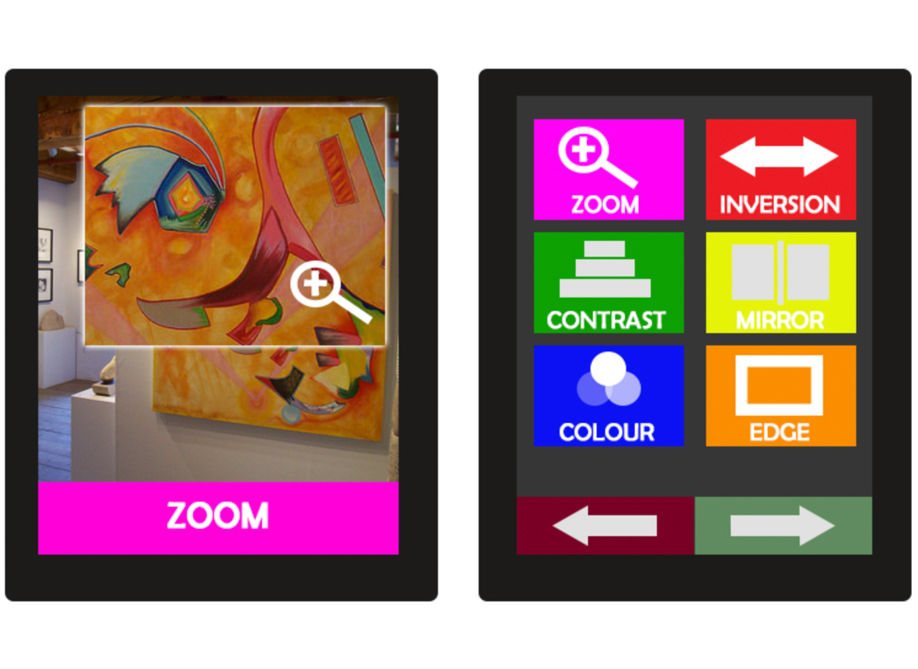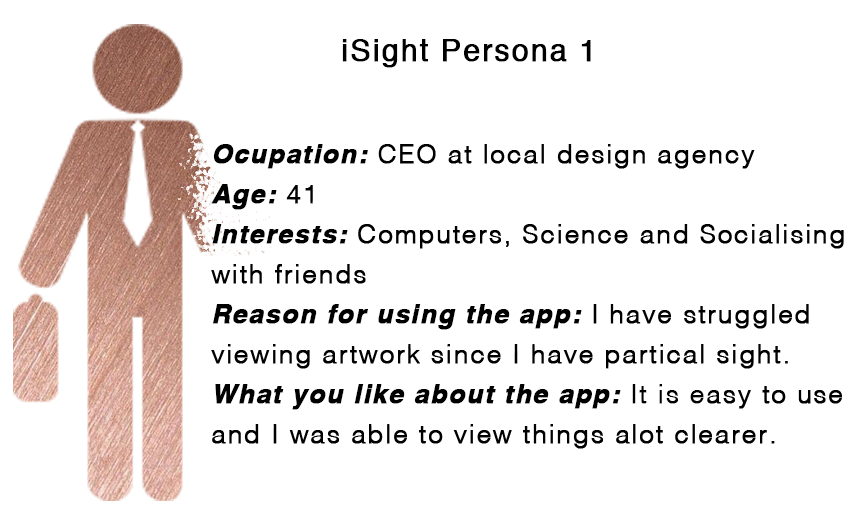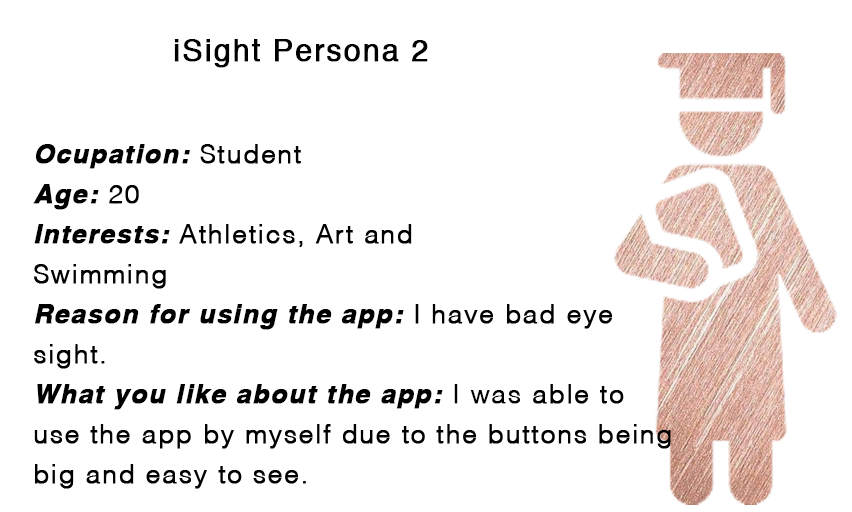


As a group we had to design and create an interactive software for a device to be used at the Transmedia end of year show. See below.



Project Brief
Our group came up with i-Sight. i-Sight is a concept in which the partially sighted or will benefit from. As they go around the exhibition they will be given an iPad to use, along with various functions to make their experience better by being able to see image/art.
Below is the full brief from my lecturers.
Initial Ideas
For the Interactive project, we have decided to design an application for an iPad that would allow partially sighted visitors to view the work at the end of year show, all by using a camera with multiple different filters and zooming options. We have chosen this task for the project as we think that it would be a good way to ensure that all of our visitors can see and experience what the show has to offer.
Another reason why we have chosen to pursue this idea is because people with sight disabilities in the UK are often not given many options to help them gain a fulfilling experience at exhibitions and other similar events today, whilst technology is currently being developed to assist people with sight disabilities in these situations we feel that in the meantime there could be a simple way to aid them with getting a better view if they are partially sighted and including audio features for those who have more severe sight disabilities. A single app could improve the experience greatly for a lot of people.
Some research into exhibitions where accessibility is considered and ensured for those who have sight related disabilities found that some have been using different types of technology to enhance the exhibits for them, these include 3D printing technology, which allows blind visitors to produce the visuals with their mind by feeling the 3D printed objects. One exhibition dedicated to using 3D printing to enhance accessibility was one made by collaborators Professor Anne Chick and Bryony Windsor called ‘3D Printing: The Good, The Bad, and The Beautiful’. One of their main aims for the exhibition was as follows: “A key aim of this research project was capacity building through the visitors’ ability to influence the redesign of elements of the exhibition over time” (RNIB - Supporting people with sight loss, 2017). This suggests that they could be looking for more ways to improve future exhibitions and events for the partially sighted visitors by actually providing interactive exhibits and allowing the guests to try them out, and then continuing to develop what worked the best afterwards.
A dissertation on exhibitions for the blind and partially sighted called ‘A Tool-Kit For Interactive Installations’ written by Nicola L. Krause detailed how different interactive exhibits would work for their visitors. An example of how they could get the interactive installations to function is as follows: “• Interaction with the installation, or more precisely with the controlling computer, requires the visitor(s) to move about and trigger sensors (no keyboards, touch screens or the like). • The sensors are distributed in the room, on the floor, walls or ceiling - either visible or not, as required. • The results of the interactions can be: - images projected on big screens or walls, or displayed on video screens, or large screen displays, - sounds presented in mono, stereo or spatial form, - lights, white or coloured, switched on or off, flashing or moving” (A Tool-Kit For Interactive Installations, 2004). This could give us some pointers to help us develop our own app with the easiest controls we can for what we have; larger buttons and text ect for the partially sighted as an example.
Previous Idea



Research
For my original idea of the Ghost Tour, I researched similar games.

As a group we researched into our new idea and thats where 'I-Sight' was formed.
Current research statistics released by the Royal National Institute of the Blind (RNIB) state that “there are over two million people living in the UK that suffer from sight loss. This number is predicted to rise to around 2’250’000 by 2020” (Help.rnib.org.uk, 2018). It can be noted that the majority of exhibitions that are hosted in museums and art galleries are predominantly designed for able sighted visitors. Partially sighted or blind visitors can sometimes find such events inaccessible or they may have difficulty viewing the exhibition in a way that is comprehensible.
iSight, the name of the interactive application we are aiming to produce, seeks to address and solve these issues. iSight is an application that will be designed and implemented onto an iPad to enable partially sighted or blind visitors to move freely around the TransMedia Exhibition. The application aims to make exhibitions more suitable for the visually impaired by taking into consideration their requirements to ensure they can examine the exhibit without assistance.
The interactive application aims to achieve this goal by providing the user with a simplistic easy-to-use User Interface (UI) that delivers multiple “filters” in which the user can apply to view the exhibition in a variety of ways. We wish to deliver an experience that is entirely controlled and tailored by the individual to ensure they can interact with any of the exhibits without feeling singled out. We believe that any visitors to the TransMedia Exhibition have the right to take away a quality experience home with them. iSight will include a range of basic viewing parameters to cater for users who have borderline sight issues all the way up to the users would are completely blind. We wish to incorporate the use of sound within our application to provide the users who are fully blind with information about the TransMedia exhibition. We hope to achieve this goal by placing sensors around the exhibition that track the user’s movements when they are walking around the event. The sensors would initiate a response through the device so that users can build a picture in their mind of their surroundings. This feature can also provide user’s who are only slightly visually impaired an auditory reinforcement to what they are seeing on screen.
There is a wide range of disabilities that can cause visual impairment. We aim to cater for as many as possible to ensure that anybody who attends the TransMedia exhibition with such an illness will be able to enjoy the event.
We hope to include features for users who suffer from Albinism, Cataracts, Diabetic Retinopathy, Glaucoma, Macular Degeneration, Retinitis Pigmentos and Total Blindness. Each feature will provide the user with a different way of viewing the exhibition. It is in their control to find what feature suits them the best by navigating through our User Interface. The user will be able to touch a button in either one of the left or right corners to scroll through the viewing parameters. Please see Appendix I, (Hodge, 2016), for an example as to how somebody with a visual impairment listed above may see his or her environment. Appendix II, (Krause, 2004), provides a visual representation of what we are aiming to produce but in real-time.
We gained inspiration for our interactive application by searching online for similar apps that benefit the lives of the visually impaired. Through research we found that there were applications that used similar methods we wish to incorporate to benefit the user. There is a wide range of magnifying applications that enable the user to point their phone or tablet at an object to observe it in scrutiny. Light Detector was another application that gained our attention; this allowed the user to transform any natural or artificial light source into sound. This is what inspired us to use sensors around the exhibition to playback relevant sound bites of information.
Designs
I firstly sketched ideas.


Feedback
It is good to recieve feedback throughout the project. It enables me to make changes I had not thought of and improve my work.
My lecturer found this idea to be more useful to be used at the Transmedia Exhibition.
Developed Designs
My developed ideas are below.

Further Ideas
We felt as a group it would be better the simplier the design.
Submitted Work
The final designs are shown below.



I used various software I knew already and have learned from my last year at University. It is important in third year to build on the skills we already know rather than trying to teach ourselves something new. This makes us more advanced in our specific areas of design.
The target market for this project is people that are going to attend the Transmedia Exhibition. This could be people from agencies, other students and/or lecturers. The app specfically targets people with sight disabilities.


At the end of every University year, the DMD team put together a show to demonstrate our work to others.